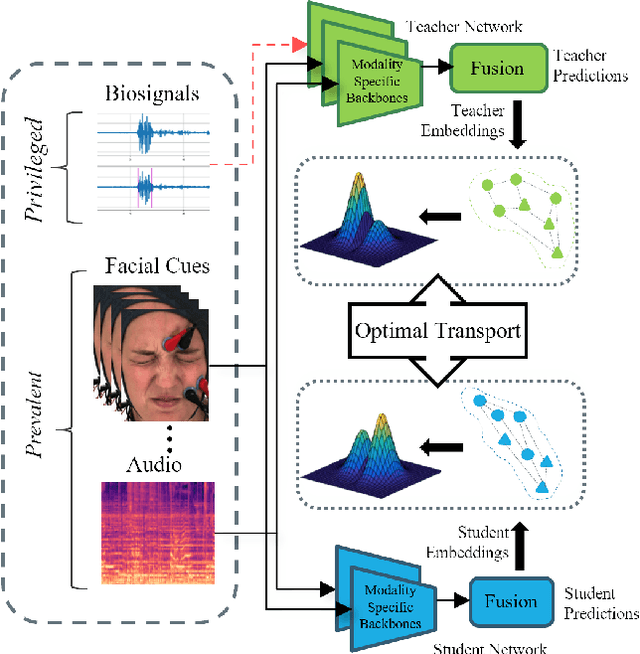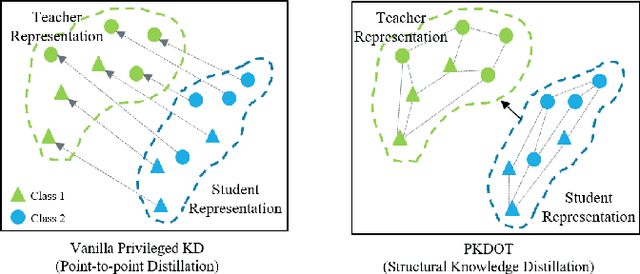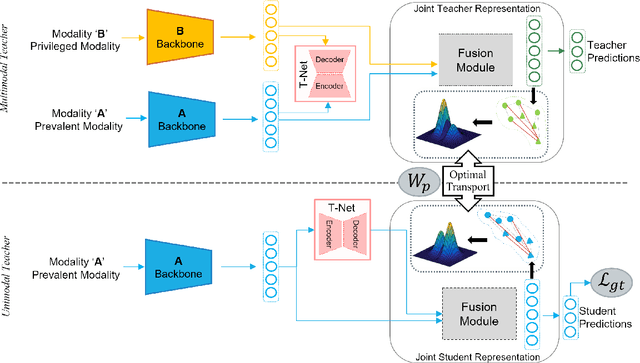Muhammad Osama Zeeshan
MuSACo: Multimodal Subject-Specific Selection and Adaptation for Expression Recognition with Co-Training
Aug 17, 2025Abstract:Personalized expression recognition (ER) involves adapting a machine learning model to subject-specific data for improved recognition of expressions with considerable interpersonal variability. Subject-specific ER can benefit significantly from multi-source domain adaptation (MSDA) methods, where each domain corresponds to a specific subject, to improve model accuracy and robustness. Despite promising results, state-of-the-art MSDA approaches often overlook multimodal information or blend sources into a single domain, limiting subject diversity and failing to explicitly capture unique subject-specific characteristics. To address these limitations, we introduce MuSACo, a multi-modal subject-specific selection and adaptation method for ER based on co-training. It leverages complementary information across multiple modalities and multiple source domains for subject-specific adaptation. This makes MuSACo particularly relevant for affective computing applications in digital health, such as patient-specific assessment for stress or pain, where subject-level nuances are crucial. MuSACo selects source subjects relevant to the target and generates pseudo-labels using the dominant modality for class-aware learning, in conjunction with a class-agnostic loss to learn from less confident target samples. Finally, source features from each modality are aligned, while only confident target features are combined. Our experimental results on challenging multimodal ER datasets: BioVid and StressID, show that MuSACo can outperform UDA (blending) and state-of-the-art MSDA methods.
BAH Dataset for Ambivalence/Hesitancy Recognition in Videos for Behavioural Change
May 25, 2025



Abstract:Recognizing complex emotions linked to ambivalence and hesitancy (A/H) can play a critical role in the personalization and effectiveness of digital behaviour change interventions. These subtle and conflicting emotions are manifested by a discord between multiple modalities, such as facial and vocal expressions, and body language. Although experts can be trained to identify A/H, integrating them into digital interventions is costly and less effective. Automatic learning systems provide a cost-effective alternative that can adapt to individual users, and operate seamlessly within real-time, and resource-limited environments. However, there are currently no datasets available for the design of ML models to recognize A/H. This paper introduces a first Behavioural Ambivalence/Hesitancy (BAH) dataset collected for subject-based multimodal recognition of A/H in videos. It contains videos from 224 participants captured across 9 provinces in Canada, with different age, and ethnicity. Through our web platform, we recruited participants to answer 7 questions, some of which were designed to elicit A/H while recording themselves via webcam with microphone. BAH amounts to 1,118 videos for a total duration of 8.26 hours with 1.5 hours of A/H. Our behavioural team annotated timestamp segments to indicate where A/H occurs, and provide frame- and video-level annotations with the A/H cues. Video transcripts and their timestamps are also included, along with cropped and aligned faces in each frame, and a variety of participants meta-data. We include results baselines for BAH at frame- and video-level recognition in multi-modal setups, in addition to zero-shot prediction, and for personalization using unsupervised domain adaptation. The limited performance of baseline models highlights the challenges of recognizing A/H in real-world videos. The data, code, and pretrained weights are available.
Progressive Multi-Source Domain Adaptation for Personalized Facial Expression Recognition
Apr 05, 2025Abstract:Personalized facial expression recognition (FER) involves adapting a machine learning model using samples from labeled sources and unlabeled target domains. Given the challenges of recognizing subtle expressions with considerable interpersonal variability, state-of-the-art unsupervised domain adaptation (UDA) methods focus on the multi-source UDA (MSDA) setting, where each domain corresponds to a specific subject, and improve model accuracy and robustness. However, when adapting to a specific target, the diverse nature of multiple source domains translates to a large shift between source and target data. State-of-the-art MSDA methods for FER address this domain shift by considering all the sources to adapt to the target representations. Nevertheless, adapting to a target subject presents significant challenges due to large distributional differences between source and target domains, often resulting in negative transfer. In addition, integrating all sources simultaneously increases computational costs and causes misalignment with the target. To address these issues, we propose a progressive MSDA approach that gradually introduces information from subjects based on their similarity to the target subject. This will ensure that only the most relevant sources from the target are selected, which helps avoid the negative transfer caused by dissimilar sources. We first exploit the closest sources to reduce the distribution shift with the target and then move towards the furthest while only considering the most relevant sources based on the predetermined threshold. Furthermore, to mitigate catastrophic forgetting caused by the incremental introduction of source subjects, we implemented a density-based memory mechanism that preserves the most relevant historical source samples for adaptation. Our experiments show the effectiveness of our proposed method on pain datasets: Biovid and UNBC-McMaster.
Disentangled Source-Free Personalization for Facial Expression Recognition with Neutral Target Data
Mar 26, 2025



Abstract:Facial Expression Recognition (FER) from videos is a crucial task in various application areas, such as human-computer interaction and health monitoring (e.g., pain, depression, fatigue, and stress). Beyond the challenges of recognizing subtle emotional or health states, the effectiveness of deep FER models is often hindered by the considerable variability of expressions among subjects. Source-free domain adaptation (SFDA) methods are employed to adapt a pre-trained source model using only unlabeled target domain data, thereby avoiding data privacy and storage issues. Typically, SFDA methods adapt to a target domain dataset corresponding to an entire population and assume it includes data from all recognition classes. However, collecting such comprehensive target data can be difficult or even impossible for FER in healthcare applications. In many real-world scenarios, it may be feasible to collect a short neutral control video (displaying only neutral expressions) for target subjects before deployment. These videos can be used to adapt a model to better handle the variability of expressions among subjects. This paper introduces the Disentangled Source-Free Domain Adaptation (DSFDA) method to address the SFDA challenge posed by missing target expression data. DSFDA leverages data from a neutral target control video for end-to-end generation and adaptation of target data with missing non-neutral data. Our method learns to disentangle features related to expressions and identity while generating the missing non-neutral target data, thereby enhancing model accuracy. Additionally, our self-supervision strategy improves model adaptation by reconstructing target images that maintain the same identity and source expression.
Distilling Privileged Multimodal Information for Expression Recognition using Optimal Transport
Jan 27, 2024



Abstract:Multimodal affect recognition models have reached remarkable performance in the lab environment due to their ability to model complementary and redundant semantic information. However, these models struggle in the wild, mainly because of the unavailability or quality of modalities used for training. In practice, only a subset of the training-time modalities may be available at test time. Learning with privileged information (PI) enables deep learning models (DL) to exploit data from additional modalities only available during training. State-of-the-art knowledge distillation (KD) methods have been proposed to distill multiple teacher models (each trained on a modality) to a common student model. These privileged KD methods typically utilize point-to-point matching and have no explicit mechanism to capture the structural information in the teacher representation space formed by introducing the privileged modality. We argue that encoding this same structure in the student space may lead to enhanced student performance. This paper introduces a new structural KD mechanism based on optimal transport (OT), where entropy-regularized OT distills the structural dark knowledge. Privileged KD with OT (PKDOT) method captures the local structures in the multimodal teacher representation by calculating a cosine similarity matrix and selects the top-k anchors to allow for sparse OT solutions, resulting in a more stable distillation process. Experiments were performed on two different problems: pain estimation on the Biovid dataset (ordinal classification) and arousal-valance prediction on the Affwild2 dataset (regression). Results show that the proposed method can outperform state-of-the-art privileged KD methods on these problems. The diversity of different modalities and fusion architectures indicates that the proposed PKDOT method is modality and model-agnostic.
Subject-Based Domain Adaptation for Facial Expression Recognition
Dec 09, 2023



Abstract:Adapting a deep learning (DL) model to a specific target individual is a challenging task in facial expression recognition (FER) that may be achieved using unsupervised domain adaptation (UDA) methods. Although several UDA methods have been proposed to adapt deep FER models across source and target data sets, multiple subject-specific source domains are needed to accurately represent the intra- and inter-person variability in subject-based adaption. In this paper, we consider the setting where domains correspond to individuals, not entire datasets. Unlike UDA, multi-source domain adaptation (MSDA) methods can leverage multiple source datasets to improve the accuracy and robustness of the target model. However, previous methods for MSDA adapt image classification models across datasets and do not scale well to a larger number of source domains. In this paper, a new MSDA method is introduced for subject-based domain adaptation in FER. It efficiently leverages information from multiple source subjects (labeled source domain data) to adapt a deep FER model to a single target individual (unlabeled target domain data). During adaptation, our Subject-based MSDA first computes a between-source discrepancy loss to mitigate the domain shift among data from several source subjects. Then, a new strategy is employed to generate augmented confident pseudo-labels for the target subject, allowing a reduction in the domain shift between source and target subjects. Experiments\footnote{\textcolor{red}{\textbf{Supplementary material} contains our code, which will be made public, and additional experimental results.}} on the challenging BioVid heat and pain dataset (PartA) with 87 subjects shows that our Subject-based MSDA can outperform state-of-the-art methods yet scale well to multiple subject-based source domains.
 Add to Chrome
Add to Chrome Add to Firefox
Add to Firefox Add to Edge
Add to Edge